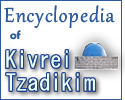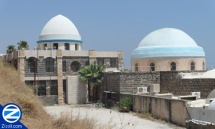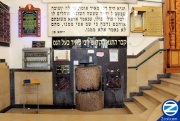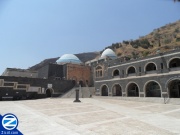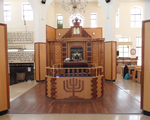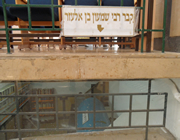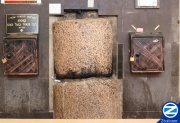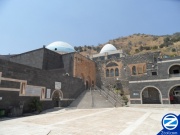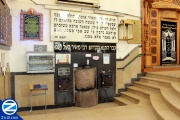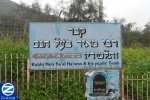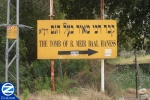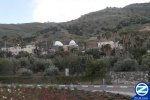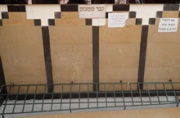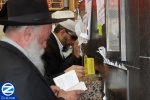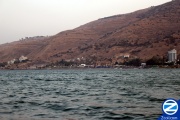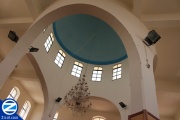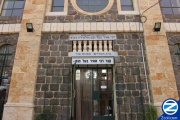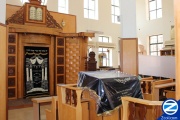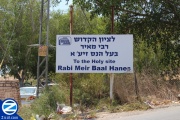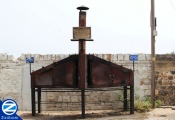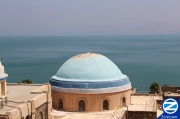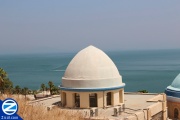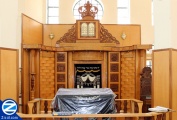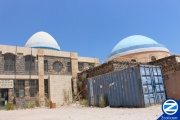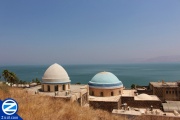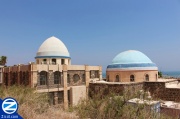Rebbe Meir Baal Haness
Rabbi Meir Bal Hanes was a fourth generation Tana and one of the most respected Jewish Sages during the time of the Mishnah (139-163). Rabbi Meir served as one of the main leaders in Israel during the generation following the Bar Kochba rebellion. He is buried in the outskirts of Tiberias, near the shores of the Kinneret. Rebbe Meir Baal Haness has a reputation of being a miracle worker even after his death. Many people have achieved salvation after a pilgrimage to his tomb or by offering a prayer and charity in his merit.
Contents |
[edit] Rabbi Meir's Name
Rabbi Meir's true name was Nahori but was nicknamed Meir which means 'to illuminate', since he illuminated the eyes of the Sages with his Halachic teachings. Nahori itself can also refer to illumination, it can also come from the Aramaic term for memory since due to his teachings the Sages would remember the Halochos they had learned. During the time of Rabbi Meir there was another sage named Nahori and it could be that his name was changed to the similar meaning word Meir to differentiate between the two sages. In Aramaic he was also referred to as Misha.
Due to his reputation as a miracle worker, Rabbi Meir was given the title of 'Baal Hanes' which translates literally as 'master of the miracle'. Use of the epithet 'Bal Hanes' is relatively recent and was first documented only 400 years ago.
In some places Rebbe Meir is referred to as Acharim 'others'. He received this title after his controversy with the Nasi, Rabbi Shimon ben Gamliel. When the Mishnah was transcribed this title stuck for the teachings Rabbi Meir said in the name of Elisha ben Avuyah, Acher 'the other'.
Unlike all his other friends, Rebbe Meir is not titled with his father's name, probably because he was descendant and possibly a son of the Roman general Nero.
[edit] Life of Rabbi Meir
[edit] Student of the Sages
In his youth Rabbi Meir excelled as a Torah scholar and merited to study under Rabbi Akiva, the leading Sage of the generation. Due to Rabbi Akiva's overwhelming sharpness, he was unable to grasp his teachings. Rabbi Meir was forced to temporarily study under Rebbe Yishmael. One he had fully mastered the teachings of the Gemora from Rebbe Yishmael, Rebbe Meir returned to Rebbe Akiva to study advance logic and reasoning. Rabbi Akiva greatly respected his student and even sat him in-front of Rabbi Shimon bar Yochi.
It was during this time that the Roman persecution was taking place, prohibiting the Jews of keeping even basic Mitzvot. Rabbi Meir recounted how they had to whisper the Shma while studying in front of Rabbi Akiva due to a Roman guard placed at the entrance of the Bais Medrash.
After studying under Rebbe Akiva, Rabbi Meir moved to Southern Israel due to the harsh Hadrianic decrees. When Rebbe Akiva's 24,000 students died in a plague leaving the world of Torah empty, he traveled to Southern Israel and gave over the full extent of his teachings to Rabbi Meir and four other Sages.
[edit] Saved from the Sea
Once while traveling with Rabbi Akiva but on different ships, Rebbe Meir's ship sunk. Rabbi Akiva was very sorrowed by the drowning of his student. When Rebbe Akiva reached his destination he received a surprise visit from Rabbi Meir who recited how he was miraculously pushed from wave to wave until he was thrown ashore.
[edit] Smicha
Rabbi Meir originally received Smicha from Rabbi Akiva along with Rebbe Shimon bar Yochi but it was not accepted by the Sages due to his young age.
After the Bar Cochva revolt and the destruction of Beitar, the Roman Emperor Hadrian initiated severe prosecution against the Sages and the dismentors of the Torah. Due to his decrees the bulk of the Sages were executed including Rebbe Meir's teachers Rebbe Akiva and Rebbe Yishmael and his father in law Rabbi Chanina ben Tardyon. A severe decree was issued against the ordination of the Smicha, saying both the organizer and the ordained would be executed and the city where it took place would be destroyed. Rabbi Yehuda ben Baba, one of the last remaining Sages, realized that the direct tradition from Sinai was about to end. Despite the great danger involved, Rebbe Yehuda gathered five of the older students, including Rabbi Meir and ordained them with the Smicha, in between the cities of Asha and Shafrum. When they were discovered by the Roman troops, Rabbi Yehuda sacrificed his life to save the five student he had just ordained, allowing them to escape.
[edit] First Escape
When Rabbi Meir's father in law, Rabbi Chanina ben Teradyon was caught teaching Torah in public, the Romans had him burnt alive holding a torah scroll as part of the Ten Martyrs. Rabbi Meir's mother in law was executed and his sister in law was sentence to live in a brothel. At the pleadings of his wife Bruriah, Rebbe Meir took a bag of gold coins and set off to free his sister in law from disgrace, disguised as a Roman horseman. After first testing her to confirm that she had retained her purity and was worthy of a miracle, Rabbi Meir approached the guard and offered him the bribe. He explained to the guard that half the money could be used to bribe his supervisors and the other half was his to keep.
When questioned by the worried guard what would happen when the money ran out, Rabbi Meir told him to say "May the G-D of Meir answer me" and that would save him in any situation. To prove his point, Rabbi Meir throw a clump of dirt at the vicious jail watch dogs, who came running to devour him. As soon as the dogs came near, Rabbi Meir said "May the G-D of Meir answer me" and they retreated. Convinced by what he had just seen, the guard released Rabbi Meir's sister in law.
Eventually the guard was convicted by the Roman government and was sentenced to death. Each time they attempted to hang him, he uttered "May the G-D of Meir answer me" and he was miraculously saved. When asked why they were unable to hang him, the guard related the entire story. Enraged, the Roman government carved an image of Rabbi Meir on the gates of the city and issued a warrant for his arrest. One day Rabbi Meir was recognized by some soldiers who proceeded to chase him. Rabbi Meir ran into a non kosher eatery and dipped his finger into a bowl of unkoser food, he then licked his other finger. When the Romans saw this they left him alone, realizing they must have mistakenly followed to wrong man since Rebbe Meir would never eat Treif. Rabbi Meir took warning from this incident and escaped to Bavel.
[edit] Valley of Rimon
During the Roman prosecutions most of the Sages went in hiding and the Sanahedrin was disbanded due to the severe decrees. After Hadrian's death the Sages once again gathered together at the Valley of Rimon. Rebbe Meir led the group of seven surviving Sages, who reinitialized the Hebrew calendar and declared a leap year. Since the death of Rabbi Akiva this was done by Chananya, nephew of Rabbi Yehoshua in Diaspora due to the Roman decrees.
When the Roman decrees loosened even more, Rabbi Meir and the Sages established a study hall in Usha. Rabbi Meir was amongst the Tannaim that expounded in honor of their hosts in Usha. When this did not work well with the Roman Government, they were forced to migrate to Yavneh. Even when they were in Yavneh the Government tried preventing them from declaring leap years. With no choice, the Sages were forced to send Rabbi Meir to Asia to establish leap years from there. When the Sages created the large gathering in Kerem Byavneh, Rabbi Meir was not present since he was still a messenger in Asia. It was around this point in time that Rabbi Yehuda bar Iloy was giving the position of head speaker by the Romans for having spoken positively about them. This was a position unofficially held by Rabbi Meir until this point.
[edit] Sanhedrin
Rabbi Yehuda bar Iloy managed to nullify many of the Roman decrees and the Sanhedrin was reestablished in Usha with Rabbi Shimon ben Gamliel as Nasi. Rabbi Nason from Bavel was appointed as Av Bais Din and Rabbi Meir was appointed as Chachom, a position that was eventually disbanded.
[edit] Controversy with the Nasi
Initially the Nasi, Av Bais Din and Chacham all shared an equal status of honor. At one point Rabbi Shimon ben Gamlil decided that in order to establish the authority of the Nasi a differentiation had to be made so its dominance could be recognized. He established a rule that when the Nasi entered the Bais Medrash all must rise and not sit until he gave permission. When the Av Bais Din would enter only two rows of students would rise and when the Chacham would enter only one would stand.
All this was done without the knowledge of Rabbi Nasson and Rabbi Meir. When they found out about this they presumed that Rabbi Shimon ben Gamliel had acted out of ulterior motives since they both knew themselves to be bigger Torah scholars then him. Together they decided to put him in his place. Knowing that Rabbi Shimon ben Gamliel was not knowledgeable is Maseches Uktzin they decided to ask him to lecture on it when he arrived the next day, publicly degrading him and forcing him to resign.
A Tana named Rabbi Yackov ben Kadshi happened to overhear their plans and sat near the Nasi that night learning Ukzin out loud. Rabbi Shimon ben Gamliel realized he lacked knowledge in that area and studied Uktzin all night. In the morning was able to turn the table on them and had Rabbi Nason and Rabbi Meir kicked out of the Bais Medrash.
From then on Rabbi Nason and Rabbi Meir sat outside of the Bais Medrash and would write their questions sending them inside. When the Sages in the Bais Medrash could not come up with an answer, Rabbi Nason and Rabbi Meir would write down the answer and send it in as well. Finally Rabbi Yossi got up and protested how the 'Torah' could sit on outside while they all sat on the inside. Rabbi Shimon ben Gamliel agreed to allow them back in but as a fine, from that point on their names were not to be mentioned openly in the Bais Medrash. Rebbe Nason would now be referred to as Yash Omrim 'there are those that say' and Rabbi Meir was to be referred to as Acharim 'others'.
Eventually Rabbi Nasson apologized to the Nasi but Rabbi Meir refused, even though he was instructed to do so through his dreams. It was during this time that an unsuccessfully attempt was made to place Rebbe Meir in Cherem.
[edit] Teveriah
Due to the controversy with the Nasi, Rabbi Meir was forced to leave the Sanhedrin. Instead he relocated to Teveriah and established a Bais Medrash there. During his time in Tevriah he would give a public sermon each Shabbos night at the Bais Medrash of Chamas. Rabbi Meir would split his lectures allotting a third to Halacha, a third to Aggadah and a third to Parables.
[edit] Second Exile
After the incident with Bruriah (see below), Rebbe Meir left Eretz Yisroel and went to Asia. One of his closest students, Rabbi Shimon ben Elazar accompanied him. Occasionally Rabbi Meir would return to Eretz Yisroel and there is a reference of him attending the wedding of Shimon son of Rabbi Yehudah Hanasi.
[edit] Death of Rabbi Meir
Rebbe Meir passed away in Asia. Before his death, Rebbe Meir requested that his body should be temporarily buried along the sea shore so the same water touching Eretz Yisroel should lap on his grave. He then instructed that a message be sent to the people of Israel saying their anointed one had died, a reference to his Smicha. He asked that they should move his body and rebury it in Eretz Yisroel in a standing position. His student followed his request and buried him in Tiberias, near the Kinneret.
After the death of Rabbi Meir, Rabbi Yehuda issued a rule banning all the students of Rabbi Meir from entering the Bais Medrash. Rabbi Yehuda felt that the presents of Rabbi Meir's disciples who had a tendency of arguing in learning was a threat to his goal of ending Halachic controversy. Sumchess pushed his way into the Bais Medrash and ended the ban with the help of Rabbi Yossi.
[edit] Professional Scribe
To earn a livelihood, Rabbi Meir worked as a scribe, writing Sefri Toras and Migilos to avoid using his Torah knowledge as a way of earning money. When studying under Rebbe Yishmoel, his teacher warned him about the seriousness of this trade; "My son, be careful with your work since it is a heavenly occupation, if you leave out one letter or add an extra one, it comes out you are destroying the entire universe."Rabbi Meir would add an additional ingredient (kankantom) to his ink to make it look nicer. In his personal Sefer Torah he would make footnotes by slightly altering the text in certain places, giving over short drashos.
Working as a sofer since his youth, Rabbi Meir continued his trade even after becoming a well respected leader. He was a master scribe and knew his work well. When Rebbe Meir traveled to Asia to declare the leap year he could not find a copy of Migilat Ester, since the local Jewish population spoke Greek and only had a version in that language. Rabbi Meir proceeded to write the entire Megilot Ester from memory. He then wrote a copy from his first copy so the second Migilah could Halachicly be used for the actual reading.
Rabbi Meir would earn 3 Silaim a week. He used a third of his profits to feed his family, a third for their clothing and accommodations and would give the remaining third to the students of Torah. When asked by his students why he did not save any money for his children, Rabbi Meir responded that if they would be righteous, Hashem would care for them and if not, then he did not want to support them, for how could he leave his money to the enemies of Hashem.
[edit] Baal Haness the Miracle Worker
Rebbe Meir was known during his life to be a miracle worker. One famous story was how he saved his sister in law from prison. Another famous story was how Rebbe Meir saved Yehuda HaEntocy, a rich miser from a snake that was set on killing him, by forcing him to give charity.
Many miracles were recorded after Rebbe Meir's death by people that visited his tomb or prayed to be answered in his merit.
[edit] Greatness of Rabbi Meir
[edit] Holiness
When Rabbi Meir visited Tzepori, Rebbe Yosi ben Chalafta praised him in-front of the people of his city, calling his a great, holy and modest individual. Resh Lakish referred to him as a 'holy mouth'.
Rabbi Meir used to laugh at people that committed sexual sins since they could not control their lust. Once the Satan himself decided to test Rabbi Meir and he almost fell but was protected at the last moment when in heaven the declared "beware of Rebbe Meir and his Torah".[edit] A Torah Scholar
He was praised by Rebbe Acha bar Chanina to have been the greatest Sage of his generation. It was the custom of Rebbe Meir to not leave the Beit Knesset until the forth hour of the day.
His friend said that he had the ability to purify a vermin with 150 reasons.
[edit] Source of Wisdom
Rabbi Yehuda Hanasi once credited to his sharp logic to having looked at the back of Rebbe Meir and had he seen him face to face he would have been even sharper. This is most likely referring to a spiritual level or to the direction of Rabbi Yehuda's seat in the Bais Medrash in relation to Rabbi Meir's seat.Rebbe Shimon ben Elazar credited his great wisdom to having served Rabbi Meir on his second escape from Eretz Yisroel and for having possession of his personal walking rod.
[edit] Submissive to Friends
Although Rabbi Meir often argued with his friends regarding Halacha, he would not act on his own opinion when the Halacha was ruled against him. Once Rabbi Meir was sick and his student Rabbi Shimon ben Elazar wanted to prepare for him a medication on Shabbos, involving the mixing of oil and wine which is permitted by Rabbi Meir. Rabbi Meir refused to use the medication since its preparation was prohibited by his colleagues and although he permitted it for other people he would never actually practice against the ruling of his friends.[edit] Humility for Shalom Bais
Once a man got angry at his wife for coming back late from Rabbi Meir's Friday night lecture. He kicked his wife out of the house declaring that he would not allow her in until she spat in the face of Rabbi Meir. After three weeks out of the house her neighbors encouraged her to approach Rabbi Meir. Through his Roach Hakodesh, Rabbi Meir saw the full situation, as soon as the woman entered, he announced that his eye was in great pain and needed a woman who knew who to whisper on a wound to ease the pain. With the encouragement of her friends the woman stepped forward. When she got closer she confessed that she did not know how to perform the ritual. Rabbi Meir told her that instead she should spit seven times in his eye. After she did this, Rabbi Meir instructed her to go home and tell her husband that while he commanded her to to spit at him once, she had done so seven times. Students who realized what happened were enraged and asked Rabbi Meir why he agreed to degrade himself when they could have physically forced the husband to make up with his wife. Rabbi Meir replied that he was no better then Hashem who agreed to have his name erased by in an incident of an accused Sotah, to preserve peace between husband and wife.
[edit] Bringer of Peace
There were two men who each Friday would become enticed by the Satan and would quarrel with each other right before it became dark. Rabbi Meir prevented them from fighting for three Fridays, until the two men made peace. Rabbi Meir then heard the Satan exclaim "Woe, take Rebbe Meir out of my home".
[edit] Tana
Rebbe Meir is mentioned many times throughout the Mishnah and Talmud. He is mentioned in every single Masechta excluding Rosh Hashana, Chagiga, Tomid, Kinim, and Zovim. In Masechta Kilayim alone, Rabbi Meir is quoted 29 times. All together there are three hundred and thirty five laws throughout the Mishna that are quoted directly from Rebbe Meir. All anonymous Mishnahs are also attributed to Rabbi Meir since Rebbe Yehuda Hanasi created the Mishnah based on the teachings of Rabbi Akiva as they were transmitted through Rabbi Meir. Any time an anonymous student is quoted reciting the teachings of Rabbi Yishmael in front of Rabbi Akiva, it is referring to Rebbe Meir who studied under both of them. It can be assumed that Rabbi Meir was well versed in the mysteries of the Kabbalah, since his teachers were some of the greatest Kabbalists of the generation.Rabbi Meir mostly argues with Rabbi Yehuda bar Iloy and Rabbi Yossi although there are numerous other Tanaim he argues with throughout the Mishna. Although Rabbi Meir argued many times on his friends he would act according to their opinion if the Halacha was ruled against him. Rabbi Meir is also quoted many times in Braysos throughout the Talmud.
[edit] Foundation of the Mishna
Although most of the Sages of his generation were students of Rabbi Akiva, it was Rabbi Meir that inherited Rabbi Akiva's Torah terminology and his tradition formed the core base of the Mishnah. It is therefore the reason that all anonymous Mishnayos are attributed to him.
He created Mishnas Rebbe Meir which served as one of the pillars for the final Mishna sealed by Rabbi Yehuda Hanasi. All his teachings are given in a very short and terse method and Rebbe Meir himself said that a person should always give over teachings to his students in the shortest possible way.
[edit] Halacha Ruled Against Him
Rabbi Meir was able to give many reasoning to purify the impure and to impurify the pure. When students would ask him a question he would often give numerous arguments for both sides, to sharpen and test his students. It is for this reason that the Halacha is often ruled against Rabbi Meir, since the Sages could not fully reach the depth of his wisdom and differentiate what his true opinion was. In cases where Rabbi Meir created decrees to strengthen the existing rules the Halacha is often ruled like him.
[edit] Teachings
- Rebbe Meir taught that the Jews our considered children of Hashem even at times when they do not act as his children and Hashem has mercy on individuals even if they are not worthy of it.
- Rabbi Meir also teaches the power of Repentance and says that when a single person does Teshuva he brings forgiveness for himself and the entire world.[1]
- Rabbi Meir would judge a person by his name, since he believed that symbolizes a persons essence. Once he was traveling with two of the Sages and he avoided being robbed by a wicked innkeeper since he knew to stay away based on his name.
- Just like his master Rabbi Akiva and his teacher before him Rabbi Nachum Ish Gamzu, Rabbi Meir used to say "Everything that Hashem does is for the good".
- From when does a small child merit a share in the World to Come, Rabbi Meir says from when he begins answering Amen.[2]
- Rabbi Meir was accustom to saying "decide with all your heart and all your soul to know My ways and sit by the doors of My Torah, guard My Torah in your heart, and in front of your eyes should be My fear, guard your mouth from all sin, purify and sanctify yourself from all evil and wrongdoings and I will be with you in all places."[3]
[edit] Parables
Rabbi Mair was known for his parables and would split his lectures allotting a third to Halacha, a third to Aggadah and a third to Parables. It was said upon him that he know 300 parables just about foxes. From all these parables we currently know only 3 of them, grouped as a single story on the verses אבות אכלו בוסר ושיני בנים תקהינה, מאזני צדק אבני צדק, צדיק מצרה נחלץ ויבוא רשע תחתיו. After Rabbi Meir passed away, the era of those that could create parables was over.
[edit] Family
Rabbi Meir was the son in law of Rabbi Chanina ben Teradyon, marrying his daughter Bruriah. Rebbe Mair was a descendent of the Roman general Nero, who while leading an attack on Jerusalem, got scared of Divine vengeance, ran away and converted. Given the proximity of the destruction of the Temple to the birth of Rabbi Meir, it is very likely that Nero was his father or grandfather.
[edit] Bruriah Wife of Rabbi Meir
Bruriah was the daughter of Rabbi Chanina ben Teradyon and was renown for her great brilliance and wisdom. She is one of the few women that are mentioned numerous times in the Talmud. So knowledgeable in Torah was Bruriah that she was able to give rebuke the Sages and won Talmudic arguments with them.
In Rabbi Meir's neighborhood lived some mobsters that would harass him. In order to save them from sinning more, Rabbi Meir started praying that they should die. Bruriah insisted that instead he pray that they should repent, which he did and that is what happened.
Bruriah's end was rather unfortunate. Bruriah was considered one of the smartest Jewish women of all time and she used to scoff at the saying of the Sages that all women were light headed. In her personal text book of the Sages teachings she added the following the following words to that line "except for Bruriah". Rabbi Meir warned her that in the end she would be forced to admit that the words of the Sages were true. Knowing that when a great person scoffs at the teachings of the Sages, he will ultimately be tested in that area by heaven, Rabbi Meir decided that he must create the test himself so it could be semi controlled.
Rabbi Meir instructed one of his close disciples to try and seduce his wife to sin. This student tried for many days until in the end she agreed. At the last moment Rabbi Mair traded places with his student without the knowledge of his wife. When Bruriah realized that she had been set up by her husband, she committed suicide by strangling herself.
[edit] Children
Rabbi Meir had two sons that both passed away at the same time as Rabbi Meir was giving his weekly Shabbos sermon before Mincha. When he arrived home, Bruriah hid the fact from him until after he made Havdala and then slowly broke the news to him, comforting him that it was a decree from Hashem. Rebbe Meir's sons were also great in Torah but passed away young since according to their level they wasted time eating and drinking when they should have been in the study hall.
Aside from his two sons Rabbi Meir was also know to have had a daughter. Her husbands name was Zvusoy.
[edit] A Second Wife
Rabbi Meir had a second wife, possibly after the death of Bruriah. This wife was a daughter of Zirurz and sister of Rabbi Yehoshua ben Ziruz.
[edit] Brother
Rebbe Meir had a fictional brother named 'Ki Tov' whom he used as an excuse to delay a midnight exit from a hotel and foil the scheme of the wicked innkeeper who was planing to rob him. 'Ki Tov' in reality was a reference to the morning sun.
[edit] Companions
[edit] Teachers
Rebbe Meir studied mostly under Rebbe Akiva although for a period of time he studied under Rebbe Yishmoel. He was also a student of Elisha ben Avuyah who eventually became an apostate and was renamed Acher. Rabbi Meir also studied a little under Rabban Gamliel.
[edit] Student of Acher
Even after Elisha ben Avuyah went bad, Rabbi Meir continued to learn from him. He tried to keep the good, separating it from the bad, similar to eating the inside of a fruit and throwing away the peal. Rebbe Meir was once delivering a sermon on Shabbos and he was told that his master Acher was outside the bais medrash riding a horse deliberately desecrating the Shabbos. He followed his former teacher as he continued to desecrate the Shabbos, trying to convince him to repent. Elisha ben Avuyah refused saying that he had heard a Bas Kol from behind the Kodesh Hakodashim on Yom Kipor declare that everyone could repent aside from Acher.
To prove his point Acher took Rabbi Meir around to thirteen study halls, randomly asking the young students to quote him the verse they were learning. Each verse quoted was a direct indication that Acher was doomed and had no chance to repent.
Although Elisha went off he did not try to corrupt Rebbe Meir and even warned him when they were about to leave the Tichum Shabbos.
When Acher became ill, Rabbi Meir remained with him until his death, trying to get him to repent even at his last moments. As he died Elisha ben Avuyah cried and Rabbi Meir was happy, believing that his teacher had done Teshuva. After Acher was buried, a heavenly flame came down to consume the grave. When Rabbi Meir heard this he came and spread his tallis upon the grave, making a personal commitment to rectify his teacher, if Hashem would not do so Himself, thereby extinguishing the fire.
After Acher's death the heavenly tribunal did not want to send him to Gehenum due to the Torah he had studied. At the same time they could not give him any reward due to the grave sins he had committed. Rabbi Meir decided that it was better that his teacher go to Gehunim so he may eventually enter the Next World after he had been rectified. Rabbi Meir declared that when he would pass away he would bring Acher into Gehunim. When Rabbi Meir passed away, smoke started coming out of the grave of Elisha ben Avuyah. Smoke continued to come out of Acher's tomb for many years until Rebbe Yochanan passed away and pulled him out of Gehunim.
Due to his studies under Acher, Rabbi Meir's teachings were not quoted by G-D in Heaven. Although it was known that Rabbi Meir's intentions were for the good, G-D refrained from quoting him until Rabbi Meir Rabba bar Shila defended him in front of Eliyaho. It was only when Rabbi Meir Rabba bar Shila declared below saying "Rabbi Meir found a pomegranate, he ate its fruit and threw out its peel", that this position was adopted above and his teachings started being quoted.
Allusion of a Pomegranate - רמון is equivalent to 296, deduct רע which is equivalent to 270 and you are left with 26, the equivalent of the Shem Havaya, the essence of good.
[edit] Colleagues
Rabbi Elizer ben Yackov, Rabbi Yehuda bar Eloy, Rabbi Shimon bar Yochi, Rabbi Yosi, Rabbi Nechemya, Rabbi Nason, Rabbi Shimon ben Gamliel, Rabbi Yossi ben Chalafta, Rabbi Elazer ben Shamua, Esey ben Yehudah, Chanina Ish Ono, Rabbi Chanina ben Antigunus, Rabbi Elazar son of Rabbi Yosi, Rabbi Yochanan Hasandlar, Rabbi Shimon ben Gamliel, Rabbi Shimon Shezuri.
Rabbi Meir was an acquaintance of the renown gentile greek philosopher Avnimus HaGredi and had a number of conversations with him, also comforting him after the death of his mother.
[edit] Students
Sumches was the main student of Rabbi Meir and is buried alongside him in Tiberias. His other students included Rebbe Shimon ben Elazar, Rebbe Yehuda Hanasi, Efraim Makshe, Rabbi Dustoey from Cocheva, Rebbe Yehuda ben Shamua, his brotherin-law Rabbi Yehosue ben Ziruz and Rebbe Yehoshua ben Peter.
[edit] Tomb of Rebbe Meir Baal Hanes
Kever of Rebbe Meir is found in Southern Tiberias near the shores of the Kinneret above the famous hot springs. Alongside him is buried his student Sumches. There are two Bati Medrashim built over the grave of Rebbe Meir. One is controlled by the Sephardim and the other by the Ashkanazim. Sumches is buried on the Ashkanazi side.
Location of Kever Rebbe Meir bal Haness was confirmed by the Arizal. His student Rebbe Chaim Vital brings down that Rabbi Mair is buried standing up. This was most probably instructed by him so he would have the ability to greet the Moshiach as soon as he arrives. Directly on top of Rabbi Meirs grave are two stone pillars, symbolizing that he is buried standing up.
The original structure built over the grave of Rabbi Meir was destroyed during an earthquake in 1337 and its exact location was lost. Once a shepherd fell asleep on the ruins as he rested watching his sheep. Rabbi Meir appeared to him in his dream and told him that he was sleeping on his grave. On the following day, he approached the Rabbis of Tiberias and related his dream. They went to the spot and dug, revealing the two stone pillars. Shortly after this the shepherd passed away and everyone knew that it was true.
In 1742 Rabbi Chaim Abulafia moved to Tevria and built up a structure around the tomb. He also issued a ruling that all pledges in merit of Rabbi Meir had to given to the Torah scholars of Tevria. It was not until 1867 that the current buildings above the tomb was built. When they were building the building on top of Rabbi Meir's grave they shifted the two large adjacent pillars to rest on the actual grave. It took fifty men to move the first pillar and they were unable to budge the second one. Suddenly and miraculously the second jumped up and rested on top of the first one. There is an eyewitness testimony to this signed by five Rabbis from the city of Tiberias.
Kever Rebbe Meir is divided into two parts the Ashkanzi and the Sephardi. Ashkanazi Bais Medrash is run by the Ohr Torah institution who operated a Kollel there since 1900. It was here that Rabbi Yisroel Odesser found the Petek in 1922. On the Sephardi side is the 'Ktones Ohr' building that hosts the Meir Bas Ayin yeshiva first established in 1867. It is currently controlled by the Weinkin family.
Alongside the tomb of Rabbi Meir are the tombs of his student Sumches and according to some opinions also Rabbi Shimon ben Elazar.
Rebbe Yosef Chaim of Baghdad recites how during renovation of the Ashkanazi Beis the two pillar stones were removed and they were found to be directly on top of the actual grave of Rabbi Mair. It was during this renovation that the tombs of Sumches and Rabbi Shimon ben Elazer were discovered.
Every year tens of thousands of people visit the Tomb of Rabbi Meir especially on the day of his Hillulah.
[edit] Hillulah of Rebbe Meir
Exact date of Rabbi Meir's Yortzite is unknown and is not mentioned in any text. Local Sephardic tradition places his Hillulah on the 14th Iyyar, Pesach Shani. There are those that want to trace this tradition back to the Chanukas Habayis of the original building that took place on Peasch Shani and was accepted by the masses as an annual celebration in honor of Rabbi Meir. This is the same date that was accepted for the Hillulah of Rabbi Yehuda bar Ilai.There is also a custom brought down to light a candle for Rabbi Meir on the first day of Teves.
[edit] Kabbalistic Reincarnations
Nero the Roman general who attempted to destroy Jerusalem was rectified in his descendent Rabbi Meir. He was also a spark of Baba ben Butah and had to go through a similar incident where he purposely degraded himself in order to bring peace between a woman and her husband. Rabbi Meir had a woman spit in his eye seven times and Baba ben Butah allowed a woman to break two candles on his head.
Rabbi Meir was a spark of the arch angel Matat who holds on to the good side of the Tree of Knowledge. Rabbi Meir had to therefore spend his life separating the good from the evil. This is why he had to study Torah from Acher. This is also why he would always give 49 resons to purify and 49 reasons to defile.
Rebbe Meir had a very powerful soul that protected the world both during his life and after his death. This is also one of the reasons that he is buried standing up, to symbolize that his merit is entrenched like a tree.
[edit] Segulot
A well know Segula for finding lost objects is to pledge a monetary amount of money to charity in the merit of Rebbe Meir Bal Haness and then recite three times "G-D of Meir answer me!" or in Hebrew "“Elaka De Meir Aneni" (אלקא דמאיר ענני).
Some people add the following Midrash before...
אמר רבי בנימין, הכל בחזקת סומין, עד שהקדוש ברוך הוא מאיר את עיניהם. מן הכא, "ויפקח אלוקים את עיניה ותרא באר מים, ותלך ותמלא את החמת".
Another version of the Segulah is to pledge to light olive oil in memory of Rebbe Mair. In order for these Segulas to be effective it must be done as early as possible after the loss is discovered. Similar segulot are also listed for people undergoing any other suffering or drama.
[edit] Kollels and Charities
Prior to Rebbe Meir's death he proclaimed that he would intercede in Heaven for whoever gave Tzedakah in his memory to the poor of Eretz Yisroel. Many charities use Rebbe Meir's promise and reputation as a miracle worker to raise money for their institutions. Most notable is Colel Polen, a Jerusalem based Kollel which has been doing so for over 200 years. Since then this method has been copied by many other institutions and charities.
[edit] References
[edit] More Photos
- Kever Rabbi Meir Baal Haness Photo Gallery

